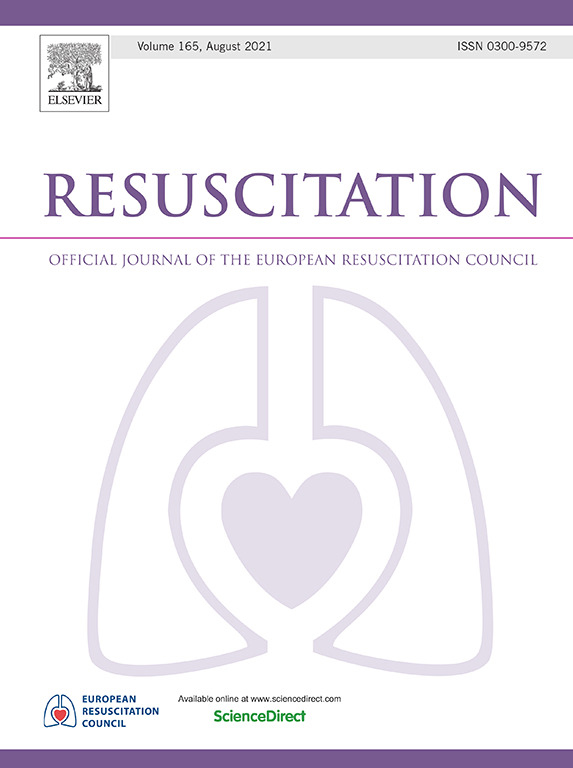公共卫生干预对院外心脏骤停患者首次胸外按压时间间隔和生存结果的累积效应
IF 4.6
1区 医学
Q1 CRITICAL CARE MEDICINE
引用次数: 0
摘要
目的:评价多种干预措施对院外心脏骤停(OHCA)患者首次胸外按压时间间隔及生存结局的累积影响。方法:我们对新加坡一项关于成人非创伤性OHCA的前瞻性国家队列研究进行了二次分析。六项全国性的干预措施依次实施,包括引入消防自行车,调度辅助心肺复苏,第一响应者公共心肺复苏培训计划,myResponder电话应用程序,Save-A-Life公共访问除颤计划和第一响应者高性能心肺复苏培训,将研究期间分为七个不同的时间段。结果是首次胸外按压的时间间隔和生存结果的系统水平估计。结果:OHCA患者第一次胸按压的时间间隔从第1 ~ 7期分别为10.6(8.5,13.4)、10.9(8.8,13.9)、7.5(0.0,11.9)、5.0(0.0,12.1)、5.0(2.4,11.9)、4.3(2.0,10.5)和4.5 (2.1,11.3)min。干预措施与缩短第一次胸按压的时间间隔(β-估计-4.09,95%可信区间(CI): -4.81, -3.37)和增加存活至出院的可能性显著相关(优势比(OR) 2.09;(95% CI, 1.39-3.14)和生存率(OR 3.06; 95% CI, 1.79-5.25),与干预前相比,实施六项全国性干预措施后神经系统预后良好。第一次胸部按压的时间间隔分别显著解释了干预与出院存活率和良好的神经预后之间的关系的21.17%和22.67%。结论:实施累积多重干预与缩短首次胸外按压时间和改善OHCA生存结果显著相关。本文章由计算机程序翻译,如有差异,请以英文原文为准。
Cumulative effect of public health interventions on time interval to first chest compression and survival outcomes in out-of-hospital cardiac arrest
Objective
To assess the cumulative effect of multiple interventions on time interval to first chest compression and survival outcomes of out-of-hospital cardiac arrest (OHCA).
Methods
We conducted a secondary analysis of a prospective national cohort study on adult, non-traumatic OHCA in Singapore. Six nationwide interventions were implemented sequentially, including the introduction of fire-bikers, dispatch-assisted cardiopulmonary resuscitation, a first responder public cardiopulmonary resuscitation training program, the myResponder phone application, the Save-A-Life public access defibrillation program and first responder high-performance cardiopulmonary resuscitation training, dividing the study period into seven distinct time periods. The outcomes were system-level estimate of time interval to first chest compression and survival outcomes.
Results
The time interval to first chest compression for OHCA patients was 10.6 (8.5, 13.4), 10.9 (8.8, 13.9), 7.5 (0.0, 11.9), 5.0 (0.0, 12.1), 5.0 (2.4, 11.9), 4.3 (2.0, 10.5) and 4.5 (2.1, 11.3) minutes from period 1 to 7, respectively. Interventions were significantly associated with reduced time interval to first chest compression (β-estimate −4.09, 95 % confidence interval (CI): −4.81, −3.37), and increased likelihood of survival to hospital discharge (odds ratio (OR) 2.09; 95 % CI, 1.39–3.14) and survival with favorable neurological outcomes (OR 3.06; 95 % CI, 1.79–5.25) after implementation of the six nationwide interventions, compared with pre-intervention. The time interval to first chest compression significantly explained 21.17 % and 22.67 % of the relationship between interventions and survival to discharge and favorable neurological outcomes, respectively.
Conclusion
The implementation of cumulative multiple interventions was significantly associated with reduced time to first chest compression and improved OHCA survival outcomes.
求助全文
通过发布文献求助,成功后即可免费获取论文全文。
去求助
来源期刊

Resuscitation
医学-急救医学
CiteScore
12.00
自引率
18.50%
发文量
556
审稿时长
21 days
期刊介绍:
Resuscitation is a monthly international and interdisciplinary medical journal. The papers published deal with the aetiology, pathophysiology and prevention of cardiac arrest, resuscitation training, clinical resuscitation, and experimental resuscitation research, although papers relating to animal studies will be published only if they are of exceptional interest and related directly to clinical cardiopulmonary resuscitation. Papers relating to trauma are published occasionally but the majority of these concern traumatic cardiac arrest.
 求助内容:
求助内容: 应助结果提醒方式:
应助结果提醒方式:


